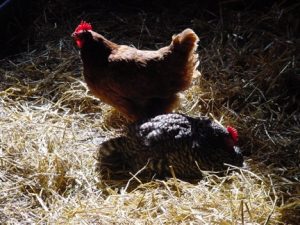Farmer’s Response to Disease Outbreaks Like COVID-19
Biosecurity, Simple Cleaning, and Disinfection Can Slow or Stop the Spread of COVID-19
 Anne Lichtenwalner, DVM, Ph.D., UMaine Extension veterinarian, associate professor, and director of the Extension Veterinary Diagnostic Laboratory
Anne Lichtenwalner, DVM, Ph.D., UMaine Extension veterinarian, associate professor, and director of the Extension Veterinary Diagnostic Laboratory
When viruses are transmitted between species (zoonotic diseases) they raise more of a concern than if we are dealing with well-known human viruses, such as the common cold. However, many strategies that farmers use to prevent illness in their livestock — such as good nutrition, hygiene, ventilation, and stringent biosecurity — are highly relevant to avoiding “new” diseases, including the novel coronavirus in China (SARS-CoV-2). This virus causes COVID-19, the newest form of coronaviral disease in people. While this new disease is a real concern, it’s important to use common sense in responding to the current outbreak.
Where did the COVID-19 virus come from? Probably bats, not livestock.
This new virus, SARS-CoV-2, is not being transmitted from livestock to people. Coronaviruses are a large family of viruses. Specific coronaviruses cause disease — often mild — in many different species of animals, including camels, cattle, cats, and bats. Animal coronaviruses may, rarely, infect people and then spread, as was seen with MERS and SARS CoV. This seems to have been the case with the COVID-19 outbreak in China, which is thought to be most closely related to bat viruses (CDC, accessed Jan. 29, 2020).
Currently, the COVID-19 virus strain has been spreading person-to-person. No animal cases have been confirmed, though there is a report that a virus similar to the COVID-19 strain was found in a dog belonging to a COVID-19 patient. The dog is not displaying symptoms. (AVMA, accessed March 4, 2020.) There is no evidence that poultry are a risk. In some countries, animal industries are affected by consumer fears rather than by actual risks.
How does the COVID-19 virus spread?
In general, coronaviruses spread through relatively close contact, but don’t survive long outside of the host. Contacting respiratory droplets from someone sneezing close to you, or picking up the virus from handling a doorknob that is contaminated with mucus from an infected person, can spread the disease. The good news is that coronaviruses can be killed by many disinfectants and normal handwashing procedures, as well as environmental exposure.
Basic responses for farmers
It’s important to note that there is no current evidence that this outbreak is affecting livestock or any species besides humans. The recommendations below apply to general precautions against introducing or spreading disease on the farm, which are excellent practices to follow at all times.
- Be sure your farm and family biosecurity is strong. Keep all visitors to your farm, wildlife, and new livestock out of direct contact with your animals, as well as their feed and water.
- Use good management to keep your family’s and your animals’ innate immunity strong. Good nutrition, housing, ventilation, water, and general hygiene will strengthen immune defenses and reduce the chance of serious disease of any kind.
- Be a good observer. Report serious illnesses to your veterinarian, processor representative, or medical professional as appropriate. While no one needs to panic, it’s always good to discuss how to best address illnesses on the farm. No matter what, usual occurrences of disease and losses will occur on farms, but shouldn’t be confused with more serious disease.
- Keep enough resources on hand to be able to manage if backups are needed. You should have replacements for essential items at the farm, as well as at least two weeks’ worth of supplies.
Cleaning and disinfecting
The Centers for Disease Control suggests simple environmental cleaning and disinfecting if respiratory disease is present. These reasonable steps for both in the home and on the farm include cleaning doorknobs, as well as kitchen and bathroom handles and surfaces. Surfaces should be cleaned using a detergent or soap and water prior to disinfection.
Diluted household bleach solutions, alcohol solutions with at least 70% alcohol, and most common EPA-registered household disinfectants should be effective. Diluted household bleach solutions can be used if appropriate for the surface you are cleaning. Follow the manufacturer’s instructions for application and proper ventilation. Check to ensure the product is not past its expiration date. Never mix household bleach with ammonia or any other cleanser. Unexpired household bleach will be effective against coronaviruses when properly diluted.
Prepare a bleach solution by mixing 5 tablespoons (1/3 cup) bleach per gallon of water or 4 teaspoons bleach per quart of water.
What about your workers?
The CDC also has some practical advice about how to address your employees’ COVID-19 concerns if the virus is confirmed in your area. More importantly, it reinforces that, if people are feeling ill, they need to take measures to avoid the spread of disease, and they need enough time and rest in order to recover. The CDC includes information about flexible work plans, and ways to keep your business running even if employees need time to recover.
Where to go for updates
Human health advisories: The CDC is mapping cases of COVID-19. Note that ANY cases in a region will turn the whole region “positive.”
Epidemiology: Johns Hopkins University has a map that is tracking the numbers and locations of cases in China. This site gives a sense of how quickly the virus spread in China and beyond. While the virus is spreading, the case fatality rate is an important thing to evaluate — highest at epicenter, lower elsewhere. Many cases have recovered.
Animal Health: The World Organisation for Animal Health (OiE) has an excellent site with relevant information on livestock and other animal health issues.
University of Maine Cooperative Extension, March 4, 2020
